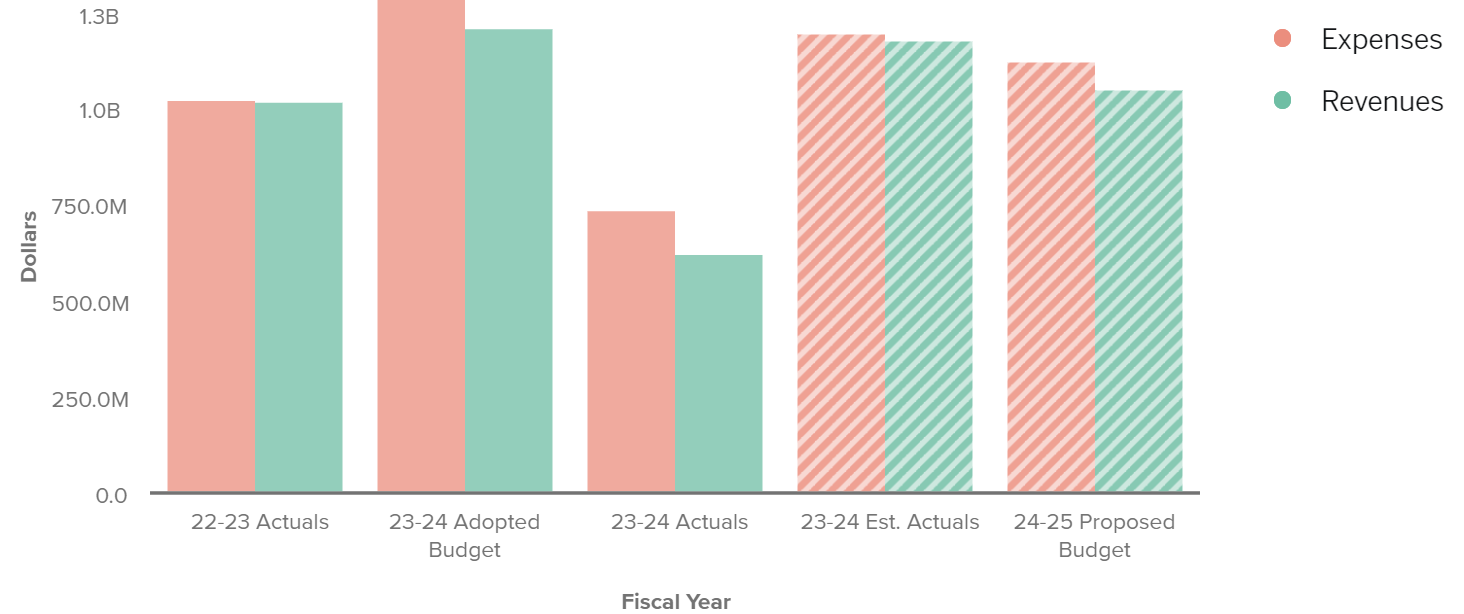
A proposed budget for 2025 cuts money for road repairs. Storms in 2023 caused about $140 million in damage to county-maintained roads, county staff said. (Jesse Kathan — Santa Cruz Local file)
SANTA CRUZ >> The financial toll of natural disasters has become an unsustainable burden on the Santa Cruz County budget, county staff told the board of supervisors Tuesday.
At an April 9 county supervisors meeting, county staff presented a draft budget for the fiscal year that starts July 1.
Santa Cruz County Supervisor Manu Koenig said more of the county’s General Fund should go toward road repairs.
“Roads are the one county service that every single one of us uses every day,” Koenig said. “By not proactively investing anything, we’re basically condemning the county road network to further and likely much more rapid degradation.”
The draft includes millions of dollars in cuts to road and facility repairs, reductions of public health staff and a proposal for the largest capital loan in county history, said Santa Cruz County Administrative Officer Carlos Palacios.
- The proposed $1.12 billion budget for Fiscal Year 2024-2025 is 6% smaller than the budget for the current fiscal year. A county summary and interactive charts for the draft budget are online.
- An $85 million loan would help cover disaster-related costs as they await federal aid. County staff have not yet named a potential lender.
- Natural disasters related to climate change are the biggest driver of the county budget problems, county staff said. Destruction from fires, floods, slides and other disasters have cost the county more than $250 million since 2017, county staff have said.
At budget hearings May 21 and 22, county staff plan to present a more detailed draft budget and seek public feedback. The final budget is set to be adopted in September.
“The picture is bleak,” Santa Cruz County Supervisor Zach Friend said of the county’s financial outlook.

Santa Cruz County staff have proposed a budget for Fiscal Year 2024-2025 that is smaller than the prior year. (County of Santa Cruz)
Money from Measure K, the half-cent county sales tax approved by voters in March, is not included in the draft budget. The tax hike is expected to bring in $5 million to $7.5 million in the fiscal year that starts July 1, then generate about $10 million annually. Measure K revenue is set to be added to draft budgets to be presented in May.
The money from the sales tax hike could be used for any county purpose. County supervisors have said they would prioritize the first year’s spending of the increased tax revenue on:
- $1 million for housing and essential workforce retention.
- $1 million for countywide homeless services.
- $1 million to support climate resiliency and county parks.
- $1 million to fund road repair and infrastructure projects.
- An unspecified amount for other county services.
Less money for road repairs, health services
The $1.1 billion draft budget preserves most county services, but slashes funds for road and facility repairs, according to a staff report.
Proposed cuts include all money for new capital projects, like new construction and repairs to county buildings. The 2023-2024 budget allocated $74.1 million to capital projects.
Construction and road projects already approved in this fiscal year’s budget would still be completed. Those projects include a South County service center in the works since 2021, and a Children’s Crisis Center next to the Santa Cruz County Sheriff’s Office in Live Oak.
More than $100 million is needed for road and bridge repairs, said Santa Cruz County Budget Manager Marcus Pimentel.
The proposed budget calls for about $56 million for road repairs, including repairs from 2017 and 2023 storms. The current fiscal year’s budget allocated $122 million for road repairs.
“There are hundreds [of repairs] that we’ve already completed. There are hundreds we have still yet to complete,” Pimentel said. “The order of magnitude of projects we can’t get to is humbling and concerning.”
The draft budget also eliminates more than 40 county Health Services Agency staff. About 28 of the positions were paid for with one-time pandemic state or federal funding.
Positions to be eliminated include:
- The equivalent of about 37 full-time health educators and other staff in the Public Health Division of the Health Services Agency.
- The equivalent of about seven full-time positions in health centers, including nurses and mental health specialists at the Homeless Persons Health Project and Watsonville Health Center.
Disaster-driven debt
The county’s biggest financial hurdle is the seven climate-fueled natural disasters the county has weathered over the past eight years, staff said.
The county has spent $250 million for disaster response since 2017. The Federal Emergency Management Agency is expected to reimburse most of the money, but county staff are still waiting on $144 million of reimbursements. Meanwhile, disaster costs are draining county coffers.
Palacios, the county administrative officer, proposed that the county take out an $85 million loan to temporarily replace money spent on disaster response. The county may be able to pay the loan back with FEMA reimbursements within three to five years, Palacios said. The loan would cost $7 million to $9 million in interest, which FEMA would not reimburse.
FEMA has dragged out reimbursements for natural disasters across the country, Palacios said. “They don’t have enough money. They don’t have enough staffing. They are working on a pre-climate change kind of model,” he said.
County staff plan to present more details about the proposed loan at a supervisor’s meeting May 14.
The draft budget would also use $6.1 million of a $7.6 million General Fund contingency fund. A smaller contingency fund could leave the county unable to pay for unexpected costs, but is necessary to bear the cost of past disasters, Pimentel said.
The contingency fund is separate from the General Fund reserve, which would remain at roughly $79.4 million.
Where the money goes
On top of disaster costs, the county has had to pay for more state-mandated county services, Palacios said. Those services include CARE courts for people with mental health and substance use disorders, and increased medical and mental health care in county jails.
Many of the mandated programs don’t include state money, so counties must pay for them. What state funding does come is often in the form of one-time grants, which makes paying for ongoing programs difficult.
County staff and supervisors should organize with groups like the California State Association of Counties to push back against unfunded state mandates, Palacios said.
The county is also expected to bear mounting pension costs until at least 2034.
“We’re in sort of a difficult position in some ways, but on the other hand, we’ve made significant progress in reducing our unfunded liability,” said Palacios. Pension costs are expected to stabilize, in about 10 to 15 years, and then drop rapidly. “It is going to be somewhat difficult for the next few years,” he said. “But for a future board a decade from now, it’s going to be a huge windfall.”
Even without natural disasters and state-mandated programs, the county’s limited tax base makes it difficult to provide municipal services to the half of Santa Cruz County residents who live outside of cities, Palacios said.
Nearly all property tax revenue collected in Santa Cruz County stays in the county, and it is split among school districts, the four cities, the County of Santa Cruz and special districts for services like libraries, water and fire protection. The County of Santa Cruz receives a smaller proportion of property taxes than some other California counties because of a state formula devised in the 1970s.
Santa Cruz County supervisors approved a resolution last year that asked state legislators to change the law.
The proposed loan and cuts “are Band-Aids to a greater, more systemic issue,” said Friend, who is set to leave the board in December. In future budget seasons, board members may have to oversee smaller budgets on par with those following the 2008 recession, he said.
Friend said the board will need to “find ways to still provide the essential services while recognizing that you don’t want to destabilize the county moving forward.”
Clarification: Some limited-term positions are ending and some unfilled positions are proposed for elimination in Santa Cruz County’s Health Services Agency. An earlier version of this story incorrectly referred to the cuts as layoffs.
Read more
- Sales tax hikes for Santa Cruz County, city win in unofficial results — March 5, 2024
- Brown, De Serpa head to November runoff for District 2 Santa Cruz County supervisor — March 5, 2024
- Property tax changes proposed in Santa Cruz County — Nov. 9, 2023
- Explainer: Property taxes in Santa Cruz County
- Election Guide, March 5, 2024: Measure K – County of Santa Cruz sales tax increase
Questions or comments? Email [email protected]. Santa Cruz Local is supported by members, major donors, sponsors and grants for the general support of our newsroom. Our news judgments are made independently and not on the basis of donor support. Learn more about Santa Cruz Local and how we are funded.
Jesse Kathan is a staff reporter for Santa Cruz Local through the California Local News Fellowship. They hold a master's degree in science communications from UC Santa Cruz.





